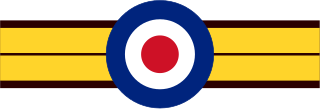No. 75 Squadron of the Royal Air Force operated as a bomber unit in World War II, before being transferred to the Royal New Zealand Air Force in 1945.
No. 515 Squadron RAF was a squadron of the Royal Air Force formed during the Second World War. It ushered in Electronic countermeasures (ECM) warfare, jamming enemy radar installations from October 1942 as the only such squadron in the RAF initially. Later in the war 515 Sqn was joined by other squadrons as part of No. 100 Group RAF. The squadron disbanded after VE day, when the need for such a specialised squadron had reduced.

No. 21 Squadron of the Royal Air Force was formed in 1915 and was disbanded for the last time in 1979.
No. 122 (Bombay) Squadron was a Royal Air Force fighter squadron during the First and Second World Wars.

No. 192 Squadron was a Royal Air Force squadron operational during the First World War as a night training squadron and during the Second World War as a radar countermeasure unit. After the war the squadron served again in the Electronic Intelligence role, until disbanded in 1958.

No. 264 Squadron RAF, also known as No. 264 Squadron, was a squadron of the Royal Air Force.

No. 105 Squadron was a flying squadron of the Royal Air Force, active for three periods between 1917 and 1969. It was originally established during the First World War as a squadron of the Royal Flying Corps and disbanded after the war. Reactivated shortly before the Second World War, it was inactive again after the conflict. During its second existence it was a bomber unit and had the distinction to be the first to operate the de Havilland Mosquito light bomber. During the 1960s it was reactivated again for six years to provide transport support for the British Army in the Aden Protectorate and the Far East.
No. 199 Squadron was a Royal Air Force aircraft squadron that operated during the Second World War and later in the 1950s as a radar countermeasures squadron.
No. 195 Squadron was a Royal Air Force aircraft squadron that operated during the Second World War, at first in the ground attack role and later as heavy bomber unit with the Avro Lancaster.
No. 608 Squadron was an Auxiliary Air Force squadron of the Royal Air Force during the Second World War. It flew during its existence as a bomber, fighter and reconnaissance unit and was the only RAF squadron to be equipped with the unsuccessful Blackburn Botha torpedo bomber.

No. 166 Squadron RAF was a Royal Air Force squadron that formed just after the end of World War I. It was the first and one of only three to be equipped with the Handley Page V/1500 heavy bomber.
No. 168 Squadron RAF was a Second World War Royal Air Force squadron that operated the North American Mustang on missions over occupied Europe and in support of the D-Day landings.
No. 571 Squadron RAF was a Second World War Royal Air Force pathfinder squadron operating the de Havilland Mosquito.

No. 411 "City of York" Squadron RCAF was a Second World War Royal Canadian Air Force squadron that operated as part of RAF Fighter Command in Europe with the Supermarine Spitfire.

440 Transport Squadron is a unit of the Canadian Armed Forces under the Royal Canadian Air Force. It is part of 8 Wing and works closely with Joint Task Force (North) located in Yellowknife, Northwest Territories.

No. 334 (Norwegian) Squadron was a Royal Air Force aircraft squadron that operated after the Second World War. Established after V-E Day, it soon became 334 Squadron of the Royal Norwegian Air Force.

No. 627 Squadron was a Royal Air Force Mosquito aircraft pathfinder bomber squadron that operated during the Second World War.
No. 140 Squadron of the Royal Air Force was a Second World War photo-reconnaissance squadron that operated between 1941 and 1945.
No. 123 Squadron of the Royal Air Force was a British aircraft squadron in the First and Second World Wars. It was disbanded for the last time on 20 June 1945.

No. 130 Squadron of the Royal Air Force was a Second World War and Cold war fighter squadron, and later a strategic missile squadron.








